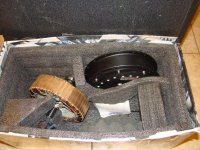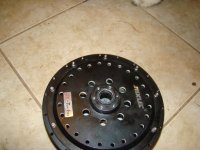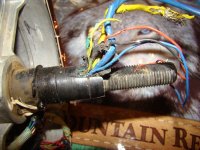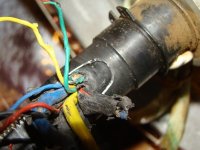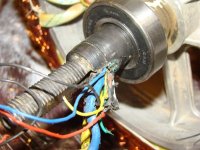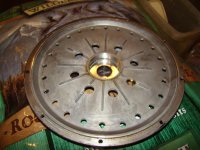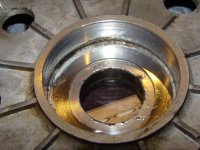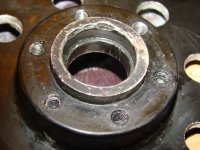RTIII said:
(My real reason to reply is

Got any pics of that canopy? I'm very curious - don't recall seeing it before.
It's in all the pics of the (whole) trike for the last several months or so. I moved it over from the bike a while back; I'd added it to CrazyBike2 originally last summer or spring, I think it was.
This is the old version canopy side view pic, taken April or May 2017, from the first post of the thread (where i try to keep updating with new images; I should probably also update the configuration there too).
Post about the install of the canopy
https://endless-sphere.com/forums/viewtopic.php?f=2&t=67833&start=375#p1250698
and pics
https://endless-sphere.com/forums/viewtopic.php?f=2&t=67833&start=375#p1250808
Since then I've altered the canopy, replacing the blue snuggie (which while a bit water repellent wasn't waterproof) with some brown naugahyde that used to be a snap-on cover for something. I've got a smaller matching one that will probably eventually be used to cover the seat once I build the next padded bench seat top with a back.
I'd like to dye or bleach it white, but I don't want to damage it; this thing has lasted for more than a decade being used for various covers for things, and I got it well-used from somewhere else years before that. White would reflect more sunlight, and also make it more visible--the brown blends in with backgrounds easily and makes the trike less visible as a whole.
The post about changeover to the new cover:
https://endless-sphere.com/forums/viewtopic.php?f=2&t=67833&start=475#p1288515
And, while you're at it, can you summarize for us the bike's current state of build? Are you running three wheel drive ATM? What motors? Etc.
[/quote]
Still only 2WD. front is still just a regular bike wheel, with dual rim brakes. Sunlite Rhino rim, 26", CST City tire with thickest Sunlite tube (actually made by CST, IIRC), 15g spokes off an old wheel.
Left rear is pedal powered as well as motor; pedals run a triple with hand-shifted chain (no derailer) if necessary, to an old Shimano333 3speed IGH (when it breaks I'll stick an old SA 3speed in there instead), with an output sprocket (that used to be part of an old multispeed freewheel) welded to the righthand spoke flange of the IGH (bolting it on just sheared the bolts). IGH shifter is below the tiller on the frame. It's geared down so far that with the granny ring on the cranks and low gear on IGH it's about 1MPH or so at a comfortable cadence, but I can keep it moving by myself without as much joint pain; don't have to stop every few dozen feet. Chain is presently an amalgam of various BMX chains, mostly old and worn, with one length of new chain in the loop from the IGH output to the transfer axle, and the loop from transfer axle to the single speed freewheel on the left motor hub. I think all the chain on the cranks to IGH loop is old.
Can't pedal decent hills (including the canal path underpasses) with it; even if the chain/etc survived the torque I wouldn't. It's so heavy that to do that I'd probably have to have motorcycle chain and sprockets, and a dual IGH to spread the load, or just use sprockets. I'd also probably want a ratcheting system I could engage on the wheels so it cant' roll backwards and I could do stop/start pedalling--crank a moment, rest while ratchets hold it in place, etc. But the pedals are honestly just emergency backups in case all the motor/battery stuff fails, given the state of my joints and strength.
Left rear motor is a used (repaired) MXUS 3K 45H 3t hubmotor run by a generic 12FET 30A controller. (sometimes gets as high as 35A peaks, IIRC).
Right rear is a well-used front Crystalyte X5304 run by basically the same controller in a different shell with slightly different factory behaviors.
Need better controllers; still collecting parts for a pair of Lebowski controllers to better run these things, to give me the startup torque I need (especially with heavy loads) to be able to get up to speed (20MPH) as quickly as possible (<2 seconds would be great) so I can get out of the way of traffic at the start of a green light when I'm stuck in the front of the line at an intersection.
(I have another MXUS, 4t, that has to be rewired and tested, that will probably replace the X5304 once I get time (trike could be down for a few days so can only do stuff like this when I can get at least a week off work). then I can see about putting the X5304 into the front wheel just for giggles to test it out; swapping back to the bike wheel if necessary).
Both rears are 20" wide ex-Zero rim, 13/14butted radial spokes, with Shinko moped tires & tubes. I forget exactly which model, SR241 or something? 2.5".
Only rear braking is electric; plain regen on the left and EABS active braking on the right.
All powered from a 14s2p 40Ah EIG NMC pack from used cells; this is charged either from the Cycle Satiator or a pair of Meanwell HLG-600 LED PSUs (depedning on how fast I want/need to charge; the satiator's max is less than 8A, the HLGs is 24A).
Monitored by a Cycle Analyst v2.3 with standalone shunt, typical cruising power at 18-20MPh seems to be around 900W on "flat" terrain; there's always some breeze or wind so it's hard to say exactly; it varies a couple hundred watts as I watch due to terrain and wind.
I'd guess present weight is 300-350lbs unloaded. Can easily carry at least that much cargo, plus my 180lbs, plus pull a trailer with at least a couple hundred pounds on it or more. Typically not used anywhere near that capacity; mostly just me. Grocery trips around 50-120lbs of stuff. Dog food runs 100-200lbs+. Dog runs about 120-270lbs at present, plus trailer weight of 30-ish lbs.
Trailer uses an automotive 1-7/8" ball hitch; I have two trailers presently setup to work with it. One is narrow enough to fit between path bollards (as is the trike, barely), the other is much wider. See the Flatbed Kennel Trailer threads, Mk III and Mk IV, for info on those.
CrazyBike2 uses the same size hitch ball to pull the trailers if needed (it doesn't have nearly the carrying capacity of the trike, so it needs them more often than the trike would).
There's probably a lot more details I could put in, but it's time to head out for work.

....back from work, so:
Separate 4s 20Ah EIG pack runs a lighting system that includes a car headlight (presently from a KIA something-or-other, found in the parking lot as I was headed home one night), used to actually see on the roads, since the cars' headlights are usually so bright in opposing traffic that it takes a very bright light to be able to see the road surface between me and them as they approach, especially on undivided/unstriped side streets.
Grin Tech LED headlight, mostly just a "see me" light, and for use on well-lit bike paths where I don't need a car headlight or it would be unhelpful.
MC incandescent turn signals either side of the headlight.
Aquarium LED modules glued to the back of old pedal reflectors mounted to the rightside mirror (used to be also on the left, but now the leftside is a Suzuki MC mirror with integrated incandescent turn signal; wish I had a second one for the right, but there was only one at goodwill).
Downlighting strip of LEDs on the front/bottom of the downtube, to light up the whole road area around the front of the trike, to make it look larger to other traffic on the road, especially that coming from behind or to the side.
Aquarium LED light for the same purpose (and to light up the cargo area/back of trike) mounted on the wire rack over the cargo deck. A second one is mounted inside the dog crate to light it up inside, whenever it's on the trike (goes in the cargo deck under the rack, blocking the other light).
Back of rack has aquarium LED lights replacing the incandescents in a couple of old Honda moped/MC taillights, in each there's two strips for tail plus a third for brake; eventually I'll add two more strips in each for brake for better daylight visibility of braking lights.
Between those units is a "third brakelight" module (incandescent) from some car; don't remember what kind, from a junkyard years back, IIRC.
Incandescent MC turn signals on the rear corners of the rack.
The whole lighting module is actually a bar bolted to the rack, so it can be removed from teh rack and bolted to the edge of the cargo deck instead, so that for tall cargo that won't fit under the rack, the rack can be removed entirely (presently this would also remove the canopy; eventually I'll fix that). Mostly I use a trailer for tall cargo instead, but sometimes I might not want to, so....
For cargo that would obstruct or otherwise be problematic with the lighting bar in either of those positions, it can be removed and tied to the cargo itself with the cargo straps that secure the cargo to the trailer, or to the back of the canopy, etc.
The trailers have a lighting bar of their own, with MC LED tailight/brake light in the center, and MC turn signals with aquarium LED lights in place of their incandescents. The bar gets moved from one trailer to the other as needed, since I don't have enough lighting for each to have their own. For cargo that would obstruct or otherwise be problematic with the lighting bar, it can be removed and tied to the cargo itself with the cargo straps that secure the cargo to the trailer.



